Eumorpha pandorus
Eumorpha pandorus, the Pandora sphinx moth or Pandorus sphinx moth, is a North American moth in the family Sphingidae. The species was first described by Jacob Hübner in 1821.
| Pandora sphinx moth | |
|---|---|
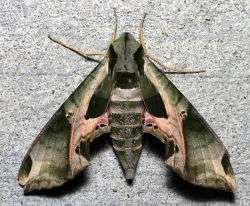 | |
Not evaluated (IUCN 3.1) | |
| Scientific classification | |
| Kingdom: | |
| Phylum: | |
| Class: | |
| Order: | |
| Family: | |
| Genus: | |
| Species: | E. pandorus |
| Binomial name | |
| Eumorpha pandorus | |
| Synonyms | |
| |
Description
It is a large, greenish-gray moth with darker patches and pink edges and small pink eyespots. The underside is usually pale yellow green or brown. It has a wingspan of 3 1⁄4 to 4 1⁄2 inches (8.2–11.5 cm), females being slightly larger than males. Pandora sphinx moths fly during dusk. Some places see only one generation a year, while others see two.
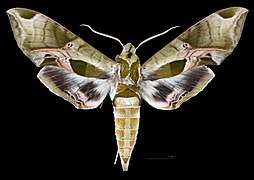 Male dorsal
Male dorsal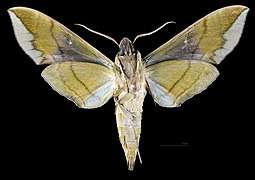 Male ventral
Male ventral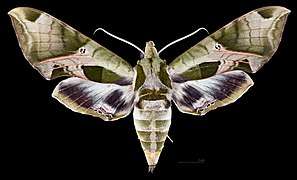 Female dorsal
Female dorsal Female ventral
Female ventral
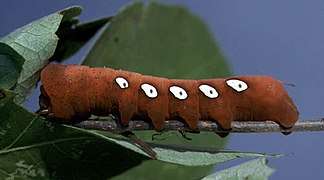 caterpillar
caterpillar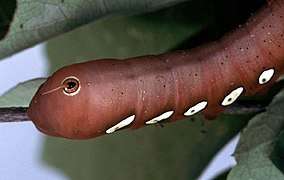 In Durham
In Durham
Distribution
The species is widespread in the east, the southeast and the center of North America, from Nova Scotia and Ontario until the south of Florida and Texas.
Biology
Female adults lay translucent eggs singly on leaves of the host plant, mainly Vitis (grapes), and Parthenocissus (Virginia creeper). Caterpillars are large, green or red with a swollen third thorax segment into which the head and first two thoractic segments can be drawn. The abdomen has a small white spot on the second segment, and big white oval spots the last five spiracles. They also have the characteristic "horn" at the end of the abdomen, until it is replaced by a button in its last instar. Larvae consume copious amounts of foliage, and when they are ready they climb down their host plant and burrow underground, where they pupate. The pupa is dark brown in color, quite slender, and has a long cremaster. There the pupa will remain for either a couple of weeks or a couple of months, depending on the generation. When the pupa is ready, it wiggles to the surface just prior to eclosion. The newly emerged adults then climb on a plant or some other surface, and pump fluid into their wings to extend them. Females emit pheromones at night, and males fly into the wind to pick up and track the pheromone plume.
References
- "CATE Creating a Taxonomic eScience - Sphingidae". Cate-sphingidae.org. Retrieved 2011-10-26.
External links
- Cotinis (October 7, 2017). "Species Eumorpha pandorus - Pandora Sphinx - Hodges#7859". BugGuide. Retrieved December 10, 2018.
| Wikimedia Commons has media related to Eumorpha pandorus. |